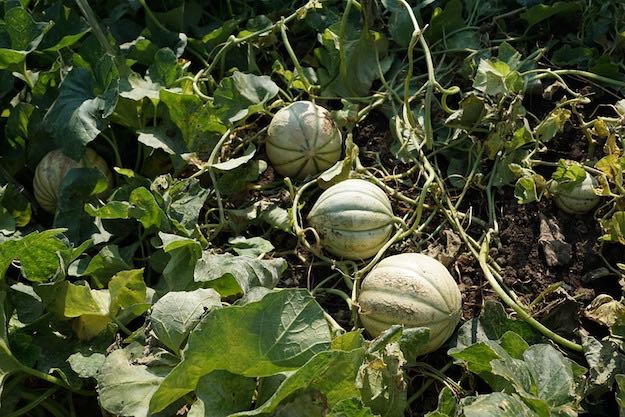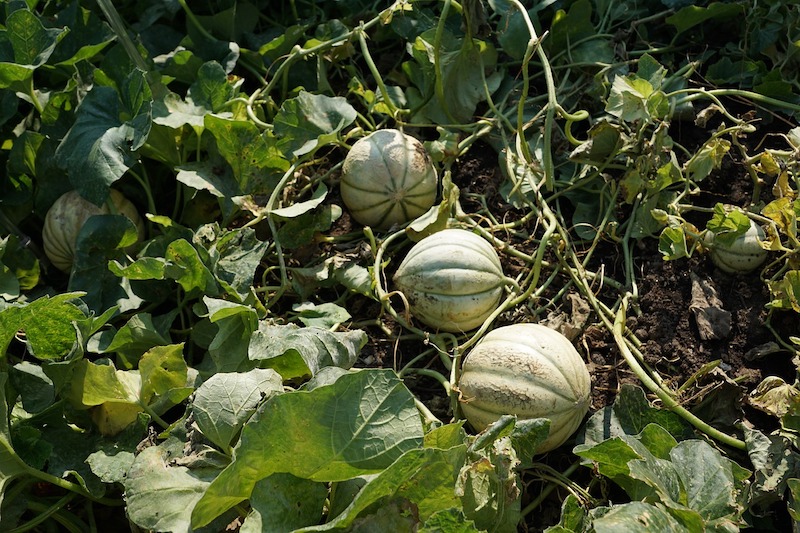Growing cantaloupe from seeds can be a fun and fruitful experiment, so don't throw out the seeds from the one you just bought from the store! Grow them in your garden this growing season for fresh and free cantaloupes!
How To Grow Cantaloupe From Seeds
Admittedly, my first attempt at growing fruits from seeds was from a little kit I bought from the grocery. It was just out of curiosity at first, but I'm now growing fruits like pear, peaches, and strawberries as a hobby. If you haven't experienced biting into a succulent cantaloupe just minutes off the vine, then you don't know what fresh fruit is! Don't miss out on this delightful treat and learn how to grow cantaloupe from seeds in this easy guide!
Collecting Cantaloupe Seeds From the Fruit

Cantaloupe, though not as sweet as honeydew, has a distinct and lovely aroma when fully ripe, making it a delectable fruit for salad and desserts. In fact, among the melon variety, it seems the cantaloupe enjoys a popularity unshared by the rest of its cousins. You can collect the numerous seeds in a fully ripe and aromatic fruit and they can be viable for growth in four years. Seeds can be bought at garden supply stores but then, don't you like your seeds free?
Germinating Cantaloupe Seeds In 5 Easy Steps
This method is a fast way to germinate seeds and in as early as 4 days, a root system will start to appear. In 10 days, they will be ready to be transplanted in small planters or directly to your plant bed if the soil has become warm. Follow the steps here for germinating the seeds indoors:
- Wash seeds you've collected from a cantaloupe fruit then dry.
- Place them on a paper towel and place the seeds an inch or more apart from each other.
- Using a spray bottle, fully dampen the paper towel with the seeds.
- Fold the paper towel and place it a Ziploc bag, then label with the date and fruit type.
- Keep the bag in a warm and dry place making sure the seeds are kept wet.
Growing Cantaloupe From Seeds In 3 Easy Steps
If you're not in a hurry and got a long growing season ahead, you can start cantaloupe seeds directly in the soil. Follow these three simple steps below to germinating cantaloupe seeds directly in the soil.
- Prepare your seed-starting kit or small planters with potting mix or compost.
- Poke holes in each section, drop a cantaloupe seed then cover with soil.
- Moist the seed starting kit or planters and place them in a sunny spot or under grow lights.
Growing Cantaloupe Seedlings In Plant Beds

Prepare a soil bed of sandy and loamy soil in the sunniest area in the garden. Warm up the seedlings for growing in-ground by gradually exposing them outdoors in 10 days. When both your soil and seedlings have been prepared, dig holes in the plant bed 3 to 4 feet apart. Plant the seedlings then give the plants a good watering. Covering the base around the plant with mulch is a good idea.
How To Grow Cantaloupe From Seeds In Containers
Think you've got no space for growing vine plants like cantaloupes? Think again because you can grow them in containers even in your apartment deck. All you need is a sunny spot, a well-draining soil in a container and, tender, love, and care for your cantaloupe plant.
- Layer a container with pumice, nutshells, or perlite for an improved drainage.
- Then fill it up with compost mixed with a sandy soil ideal for growing cantaloupe.
- Dig a hole as deep as the cantaloupe seedling's root ball or system.
- Plant the seedling then water thoroughly.
- Put up a trellis for the cantaloupe plant to cling and climb on.
Cantaloupe Plant Care Tips
Companion planting is a natural way to help keep pests and diseases from your cantaloupe plant. Marigold and herbs are the common companion plant for cantaloupe but nasturtium and tansy seem to be the most effective.
Continue to water the cantaloupe plant according to schedule but avoid overwatering if you don't want to develop bland fruits. Mulching can be a simple yet effective way to retain moisture and prevent weed growth.
Encourage pollinators to aid in fruit bearing once flowers start appearing. But if you cannot be sure of the birds and bees, you can help the fruit self-pollinate. You can manually pollinate the plant using a paintbrush and carefully brushing the pollen from the male to the female flowers.
While pinching off the growing shoots is advisable in pumpkin, this is discouraged in cantaloupe. When the plant starts to ripen, it will need all the leaves available to produce sugar which will make the fruit sweeter.
Tips For Harvesting Refreshing Cantaloupes

Once the fruit starts to mature and ripen, less watering is actually advised to improve the flavor of the fruit. Seed packets usually indicate the period of maturity or the harvest time for the variety of seeds. But for seeds collected from a store-bought fruit, you'll just have to follow these pointers:
- Ripe cantaloupes will emit a strong pleasant aroma which is the signature scent of the fruit.
- As the fruit ripens, the fruit's skin will be coarse, rough, and yellowish green in color.
- The stem or tendril near the fruits will dry up and a crack appears in the area encircling the stem.
- When the fruit is ready for harvest, keep a portion of the stem that holds the fruit attached for longer storage.
Find out more tips and ideas on how to grow cantaloupe from seeds in this video:
Now you know how to grow cantaloupe from seeds easily and for free. Don't miss out on the chance to bite into a tasty, fresh and succulent cantaloupe fruit – the literal fruit of your labor. Start growing more fruits this season by learning how to grow cantaloupes first!
Tried growing cantaloupe from seeds before? I'd be delighted to hear all about it in the comments section below.
Want to find out if you can grow apple trees from seeds? Find out how to grow apples from seeds here.
Don’t forget to follow us on Facebook, Instagram, Pinterest, and Twitter for more smart gardening ideas!




21 thoughts on “Growing Cantaloupe From Seeds | A Practical Garden Season Guide”
hmnmm…what if the melons the store sold were hybrid melons? Since they’re not guaranteed to be true-to-type, it’s doubtful the melons you try to grow would be exactly as you expect, right?
If you already know the answer to your question, why bother posting it?
Give it a try. If the seeds grow, great. If they don’t, then not much wasted.
Or, just continue buying them at $4+ each from the grocery and don’t attempt growing them.
One thing is for sure; if you don’t try to do something, it’s a guarantee you won’t be successful at it.
On the other hand, if you’re already a know-it-all then why post an answer? Just to show how superior you are? The person asked a legitimate and simple question. The correct answer would have been to suggest buying a known brand of seeds and growing them if the person was concerned about using unreliable hybrid seeds, which these from the grocery likely were. And about “not much wasted” – no, only one full growing season, that’s all.
growing pumkins watermellon cantalope and cucumbers
how long in till thay grow
growing from seeds
I’d suggest buying a packet of commercial seeds AND harvest the seeds from a store bought melon & plant both. Whichever produces the best fruit, continue to harvest the seeds for future crops. Part of the fun is in 5he experimentation.
Pingback: Cantaloupe Seeds: The top benefits, nutritional values, Uses, and storage
I JUST READ THE COMMENTS ABOVE SO I DONT THINK I WILL ASK ANY QUESTIONS SINCE YOU ALL SEEM TO BE VERY RUDE.
My sentiments exactly!
Original comment Bear made was fine. Gretchen, however, needs to chill. I agree with DP. Who wants to waste an entire growing season. Now, get out there and grow your own food!
Can anyone tell me how many Charentais melons one plant provides?
Pingback: Cantaloupe Seeds: The top benefits, nutritional values, Uses, and storage
I threw the Mellon seeds from a store bought Mellon in a Mint box in my garden and they’re growing strong. Not sure if they’ll bear fruit &/or how productive they’ll be, though, I do hold hope!
If I want to harvest my seeds for growing melons next year, how do I process and store them?
The article mentions using a trellis but I’d like to expound on that a bit. I’ve always grown climbing fruits and vegetables on trellises. It’s my experience that the stems will grow strong enough to support the fruit. I do this with tomatoes as well, instead of cages (I find them unattractive).
The article states to collect seeds from store bought fruit and they’ll be viable for growth in 4 years. Do I need to collect for the next 4 growing season then begin planting the 1st year’s collection? Amateur gardener here, please clarify.
I think he means up to 4 years. I harvested seeds early this year, planted them in seed translate August & replanted when the weather warmed. They are going gangbusters. Lots of flowers. It remains to be seen if the quality of fruit is retained
Thanks Ron. I’ll give it a shot planning these this year then. I’ll be back at the end of the growing season with some results.
Such a wonderful blog.. Thanks for sharing informative Post. Its very useful to me. They are really nice article.
I’m germinating cantaloupe seeds now for the first time. I spent the past two days burning a giant brush pile and clearing the plot for a garden. I spent all day today playing a lot of the ground up by hand and separating all of the metal and glass from the burnables. I am trying to use this garden as something to keep me busy while I go through recovery on a lot of different levels. Also to help me form a better relationship with my folks. I kind of think it’s pointless to post anything here but it’s worth a try. Gotta start somewhere.
Good luck with your project! Add some compost!